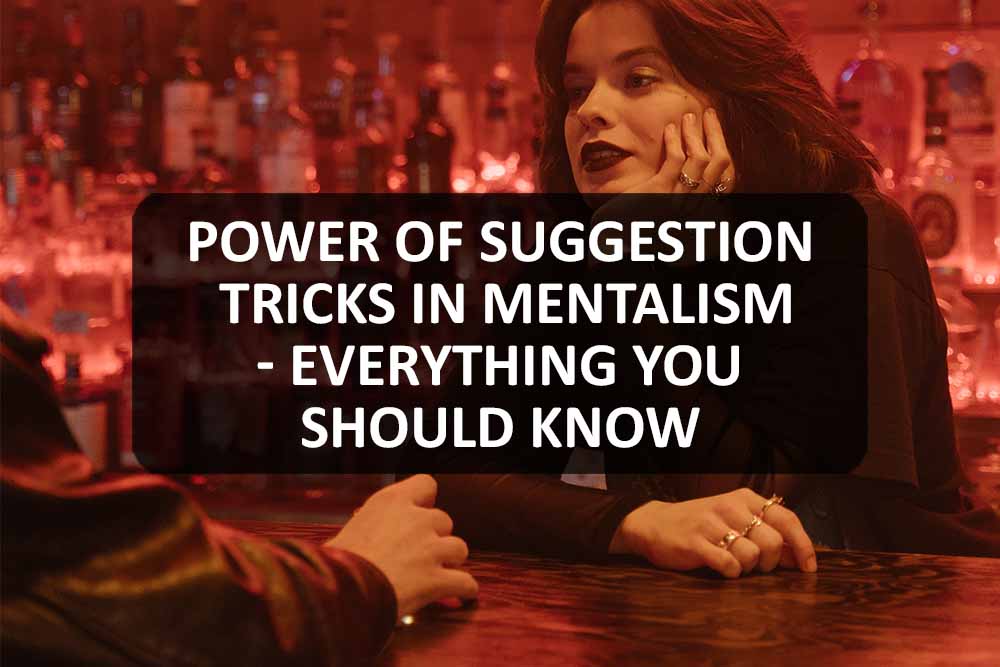Some people may think that mentalism is the same thing as magic.
However, the mind-boggling tricks professional mentalists pull are more science-based than illusions.
Psychology, the study of the human mind and behavior, plays an integral part in mentalism. We, people, think we operate purely on free will, but things we aren’t even aware of often influence the decisions we make.
“Suggestion” is an advanced trick many professional mentalists use. The idea is to make someone believe you have mind-reading abilities by suggesting and forcing a mental image into their minds and making them believe it is their thought.
Seasoned mentalists are so skilled at this technique it is almost impossible to spot.
Today, we will discuss the power of suggestion tricks in mentalism – everything you should know. This way, you’ll know how to use this trick to your advantage.
Let’s get started!
Creating the Atmosphere for a Power of Suggestion Mentalism Trick
Planting an idea in someone’s mind is not an easy task.
You’re going to have to put a lot of effort into it. That means it’s going to require more than just hand gestures, word suggestions, etc… You will need to incorporate the ideas in your surroundings, too.
For example, if you want someone to think of Alice in Wonderland, you can suggest the idea by placing a deck of cards, a cat, red roses, or perhaps a photo of a caterpillar in the room. You’d be surprised at how people’s surroundings influence their thoughts without them realizing it.
In this popular video, famous mentalist Derren Brown tricks Simon Pegg into thinking his birthday wish is a BMX bike.
At the end of the video, he reveals how he did the trick.
Apart from his subtle techniques, he also used a couple of props that would make Simon think of a bike – the round doodles on the wall decor, the red circles on the gift wrapper and the floor, the discs spinning directly behind Derren, etc…
All of this Brown carefully placed in the room to help create an image of a BMX bike in Simon’s head.
So always keep in mind that setting up the mood helps a great deal in influencing other people’s decisions.
Once you see an object, your brain processes the information, and for a while, it will linger in your head and blend in with your other thoughts. When you look at or imagine something, your brain associates its characteristics with something else.
For example, when someone asks you to pick a round fruit, and you see the color blue, you will likely think of a blueberry.
Linguistics and Body Movements in Power of Suggestion Tricks
Behavioral studies suggest that there is a correlation between language and the thought process.
When combined with a restricting factor such as a time limit, we are forced to think on our feet, which is why we would usually mutter something relevant to what we’ve just heard and perhaps seen.
In the same Derren Brown video, the professional mentalist uses linguistics to tap into Simon’s subconscious. This technique may sound complicated if you’ve just begun learning mentalism, but with practice, you will be able to successfully incorporate it in your trick.
At the end of the video, Derren Brown also revealed how he strategically placed the sounds of letters B, M, and X, as well as words that sound like “bike” in his sentences.
For example, the phrases “can be extreme” or “beam excitement for it” create subtle suggestions that Simon Pegg wanted a BMX bike as a present. The key is in repeating these words.
Apart from language, mentalists also use other suggestive methods such as hand gestures and body movements.
For example, there is a common mentalism trick where the performer asks the audience to draw a geometric shape inside another, neither of which should be a square.
Almost all the time, the audience draws a triangle within a circle. This is not just because they are probably the most ordinary shapes anyone can think of but also because the mentalist uses hand gestures – subtly projecting a triangle and a circle using simple hand movements.
Check out this video of Derren Brown using hand gestures to suggest a thought to you:
Perception Molding in Power of Suggestion Tricks
Perception molding is another psychological method of persuasion mentalists use. It involves getting a person into a mindset usually through a process called priming.
Priming means introducing content (including images) into a person’s mind to prep them.
Check out this video that uses commercials as an example of priming:
Marketing agencies use images that are highly attractive, such as beautiful destinations, luxury houses, sports cars, etc… In turn, this will likely catch the audience’s attention. Once they’ve hooked the audience, they begin to pitch their message and start selling.
Priming can also be behavioral.
For instance, you’re dying to travel to Japan with your wife, husband, or friend, but they are hesitant.
Instead of begging them, you can convince them by casually bringing up a tourist destination you think they’ll love, ordering a popular Japanese dish, or mentioning an exciting activity an acquaintance of yours experienced in the country.
After a while, your partner or friend will begin to consider traveling with you.
These are just everyday examples. Medalists add these to their tricks to suggest and persuade their audience to do what they want.
Conclusion
The power of suggestion is one of the essentials in mentalism.
It can produce a lot of great mentalism tricks that will leave people in awe.
But it can also be a useful everyday life skill. It is incredible how easily things can influence someone’s decisions and how a simple gesture, a carefully selected word, or even a tap on the shoulder can persuade a person.
With a successful use of the techniques we’ve discussed here, you can get people to believe you can read their minds or say yes to your requests.

